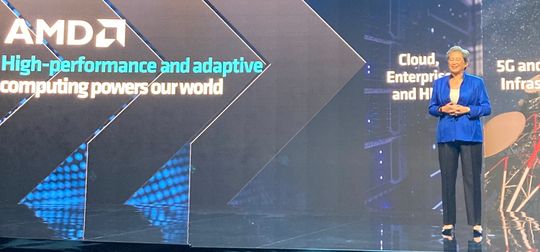AMD’s stock begins sliding during CEO’s keynote address, and finishes down 3.6%
Advanced Micro Devices Inc. officially unveiled several products at its Data Center & AI Technology Premiere event in San Francisco on Tuesday that are meant to take on Nvidia Corp. and Intel Corp., but AMD shares were under pressure following the announcements.
During her keynote address, AMD AMD, -3.61% Chair and Chief Executive Lisa Su introduced the Instinct MI300X accelerator, which was specifically designed to handle generative-AI workloads. During the keynote, Su said customers are now sampling one version, the MI300A. Su had introduced the MI300 during her CES 2023 keynote as the “world’s first data-center integrated CPU + GPU.”
Like Nvidia NVDA, +3.90%, AMD has been swept up in the hype of artificial-intelligence technology going mainstream amid the popularity of Microsoft Corp. MSFT, +0.74% -backed OpenAI’s generative-AI ChatGPT, because all those large-language models and other AI technologies require a lot of computing power from data centers.
Last year, Su called AI the company’s “single highest growth opportunity for us, the largest growth opportunity for us over the next few years.”
With the MI300X, customers can now run generative-AI models that run up to 80 billion parameters, Su said, adding that customers will begin sampling the MI300X in the third quarter and that production for the chip series will ramp up in the fourth quarter.
Additionally, Su introduced the AMD Infinity Architecture Platform, which uses eight MI300Xs for generative-AI inference and training.
This past earnings season, Su had told Wall Street analysts that “AI for us is broader than cloud,” specifically with the MI300. Back then, Su said the MI300 could reduce the length of an inference-modeling process to weeks from months.
AMD’s data-center and embedded offerings were turbocharged by its $49 billion acquisition of Xilinx, which closed in February 2022, and its $1.9 billion acquisition of data-center software company Pensando, which closed in May 2022.
During the keynote, AMD President Victor Peng, who was Xilinx CEO before the acquisition, introduced AMD’s ROCm software ecosystem for data-center accelerators, which is intended to support the Instinct MI300 and “to bring together an open AI software ecosystem,” according to the company.
That goes up against Nvidia’s AI strategy, which leverages not only its hardware but the proprietary software ecosystem that is required to run it, which has led many analysts to regard Nvidia as a software company whose main business is hardware.
Su also introduced the fourth-generation Epyc data-center CPU, codenamed Bergamo, which is intended to compete with Nvidia’s Grace data-center CPU.
AMD claims the 128-core-per-socket CPUs excel at energy efficiency while using fewer servers. During her keynote, Su said the chip delivers 1.8x performance per watt, compared with Intel Corp.’s INTC, +2.54% fourth-generation Xeon platinum CPU.
AMD shares, which had been flat when the keynote began, were down about 3% by the end of the address, and finished the regular trading session down 3.6% at $124.53. In comparison, the PHLX Semiconductor Index SOX, +1.15% rose 1.2%, the S&P 500 SPX, +0.69% gained 0.7% and the tech-heavy Nasdaq Composite Index COMP, +0.83% rose 0.8% on Tuesday.
Meanwhile, Nvidia shares closed the day up 3.9% at $410.22, making Nvidia the first dedicated chip maker to end the trading day with a market capitalization of $1 trillion.

